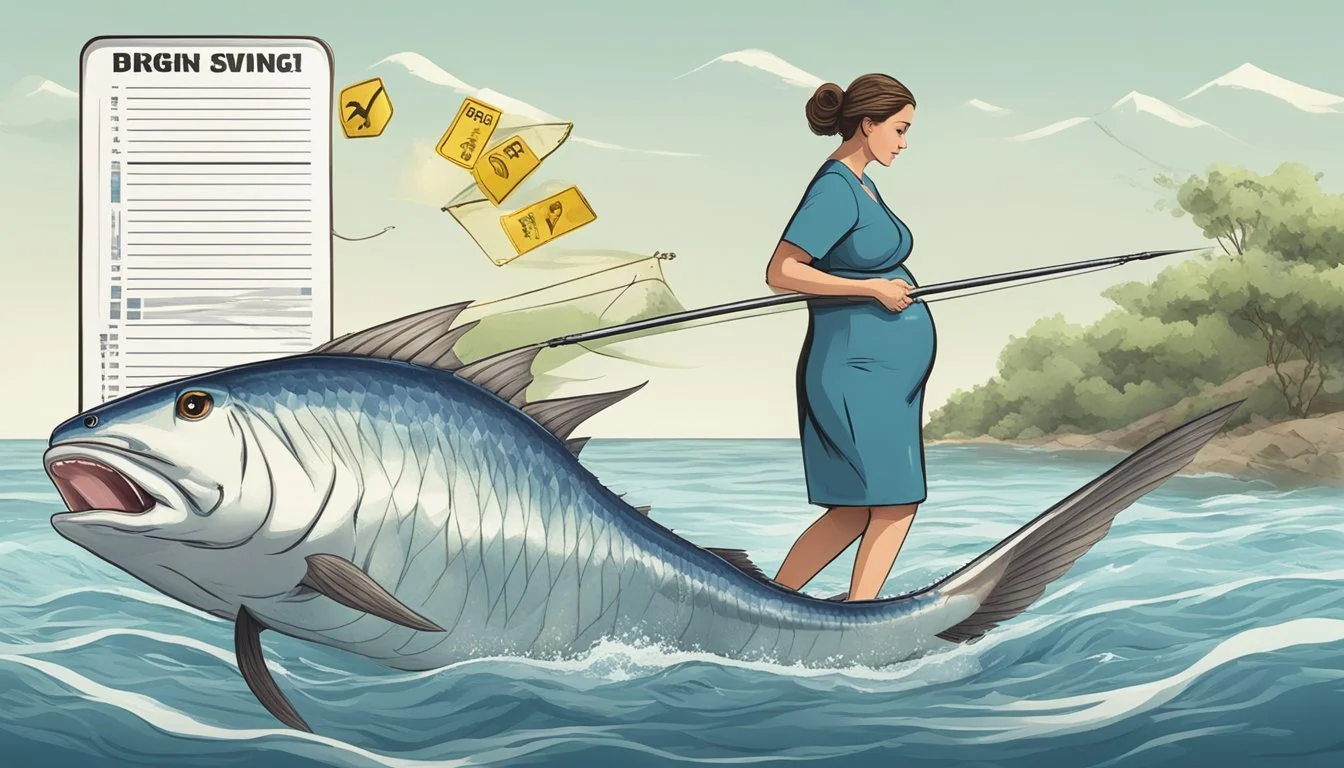Is it Safe to Eat Swordfish During Pregnancy?
Understanding the Risks
During pregnancy, the importance of nutrition comes to the forefront, not only for the expectant mother's health but also for the developing baby. Fish is a valuable source of lean protein, omega-3 fatty acids, and other vital nutrients that contribute to brain development and overall health. However, the safety of consuming swordfish during pregnancy has been subject to scrutiny due to concerns surrounding mercury levels.
Swordfish, while nutritious, is known to contain higher levels of mercury compared to other fish. Mercury is a heavy metal that can have adverse effects on the nervous system, and it is particularly problematic during pregnancy as it could affect fetal brain development. Because of this, numerous health organizations advise pregnant women to avoid consuming high-mercury fish, including swordfish.
It is widely recommended that pregnant individuals instead choose fish lower in mercury to ensure the health and safety of both themselves and their unborn child. Such low-mercury fish include light canned tuna, salmon, and sardines, which can be eaten in moderate amounts. This precaution aims to minimize any potential risks, while still reaping the nutritional benefits of seafood.
Nutritional Considerations During Pregnancy
During pregnancy, nutritional needs are heightened to support both the mother's wellbeing and the baby's growth and development. Specific nutrients, like omega-3 fatty acids and a selection of minerals and vitamins, are of heightened importance.
Importance of Omega-3 Fatty Acids
Omega-3 fatty acids, especially docosahexaenoic acid (DHA), are crucial for fetal brain development. Pregnant and breastfeeding women are encouraged to consume sources of DHA because it supports neurological and visual development in the fetus. However, when selecting fish rich in omega-3s, it is important to choose varieties with low mercury levels.
Recommended sources of omega-3s safe for pregnancy:
Salmon
Anchovies
Herring
Sardines
Trout
Protein, Iron, and Other Vital Nutrients
A pregnant woman's body requires increased protein, which is foundational for fetal growth and the expansion of maternal tissues. Iron is equally critical, as it prevents anemia by aiding in the production of hemoglobin. Zinc plays a role in cellular integrity and function, and iodine is necessary for thyroid function, which affects neurological development.
Essential nutrients for pregnancy:
Protein: Supports fetal growth and development
Iron: Crucial for oxygen transport and preventing anemia
Zinc: Aids in cell growth and DNA synthesis
Iodine: Essential for thyroid function; impacts brain development
Vitamins and other minerals: Essential for both mother and baby's health
Throughout pregnancy, selecting foods that offer these nutrients is vital, while also balancing the avoidance of foods that may pose risks, such as those high in mercury or otherwise known to be potentially harmful in pregnancy.
Understanding Mercury Exposure
When discussing seafood consumption during pregnancy, understanding mercury exposure is critical for ensuring the safety of both the mother and the developing baby.
Risks of Mercury to Pregnancy
Mercury is a neurotoxin, particularly harmful to a baby's developing nervous system. Pregnant women are advised to limit exposure to mercury as it can cross the placenta and potentially cause harm to fetal growth, including effects on brain development and cognition.
Mercury Levels in Different Types of Fish
Fish advisories are in place to protect expecting mothers from high-risk seafood. Higher levels of mercury can be found in four particular types of fish:
Tilefish from the Gulf of Mexico
Shark
King Mackerel
It is generally recommended that pregnant women avoid these fish due to their high mercury concentrations. Instead, they are advised to choose fish with lower mercury levels, offering important nutrients without posing a similar risk.
General Dietary Guidelines for Pregnant Women
During pregnancy, dietary choices impact both maternal health and fetal development. Adherence to established dietary guidelines, particularly regarding fish consumption, helps ensure the necessary intake of crucial nutrients while managing potential risks.
Recommended Fish Servings
The Dietary Guidelines for Americans recommend pregnant women consume 2 to 3 servings of fish per week. A serving size is typically 4 ounces, cooked. Fish are a vital source of omega-3 fatty acids, which support fetal brain development and provide key nutrients. The FDA highlights the importance of these nutrients during pregnancy, as they contribute to a child's brain development.
Servings per week: 2 to 3
Serving size: 4 ounces
Important nutrients: Omega-3 fatty acids (DHA and EPA)
Balancing Nutritional Benefits and Risks
While fish is an excellent source of protein and omega-3 fatty acids, pregnant women need to balance the nutritional benefits with the potential risks of mercury exposure. Certain fish high in mercury, such as shark, swordfish, king mackerel, and tilefish, should be avoided. The FDA and EPA provide a list of fish that are safer choices for pregnant women to minimize risks. Pregnant individuals should also be mindful of the proper handling and cooking of seafood to reduce the risk of foodborne illnesses.
Nutritional benefits:
Protein
Omega-3 fatty acids
Iron
Zinc
Risks to manage:
Mercury content in certain fish
Proper handling and cooking to avoid foodborne illness
Following these guidelines helps pregnant women maintain a diet that is not only rich in essential nutrients but also safe for the developing fetus.
Specific Fish to Avoid During Pregnancy
When pregnant, it is crucial to avoid certain types of fish that are high in mercury, as elevated levels can harm the developing fetus.
High-Mercury Fish and Alternatives
High-Mercury Fish to Avoid:
Swordfish: Due to high levels of mercury, swordfish should not be consumed during pregnancy.
Shark: Similarly, shark is another fish with considerable mercury content, making it unsafe for pregnant individuals.
Tilefish from the Gulf of Mexico: This regional variety of tilefish contains mercury levels that can potentially affect fetal development.
King mackerel: Another fish to exclude from the diet during pregnancy due to high mercury.
Alternatives Low in Mercury:
Salmon: A nutritious choice, salmon is low in mercury and safe for consumption in moderation.
Trout: Trout, especially farmed rainbow trout, is another low-mercury fish option.
Sardines: These small fish are not only low in mercury but also rich in essential nutrients for pregnancy.
Safe Fish Choices
When selecting seafood during pregnancy, it's crucial to opt for options that offer nutritional benefits while minimizing exposure to mercury.
Best Choices for Seafood Consumption
Best Choices are those that provide essential nutrients and are typically lower in mercury. Pregnant individuals can enjoy these fish two to three times a week:
Salmon: High in omega-3 fatty acids, protein, and vitamins.
Anchovies: Small and contain lower mercury levels.
Sardines: Nutrient-rich and low in mercury.
Trout: Often farm-raised, trout is high in omega-3s and generally low in contaminants.
Good Choices to Consider
Good Choices can be consumed but in moderation compared to the best choices:
Catfish: Farm-raised catfish is lean and offers a good protein source.
Tilapia: Popular and widely available, tilapia has moderate nutritional benefits.
Oysters: While known for their zinc content, pregnant individuals should only consume cooked oysters to avoid bacteria.
Preparing and Consuming Seafood Properly
When consuming seafood during pregnancy, it is paramount to focus on food safety to reduce the risk of foodborne illness. Ensuring proper cooking temperatures and avoiding raw fish are critical steps to protect the health of both the mother and the developing baby.
Cooking Fish to Safe Internal Temperatures
Seafood should always be cooked to safe internal temperatures to prevent foodborne illnesses. The Food and Drug Administration (FDA) advises that fish be cooked to an internal temperature of 145°F (63°C) until the flesh is opaque and flakes easily with a fork. Here's a simple guide to fish cooking temperatures:
Whole fish: 145°F (63°C)
Fish fillets: 145°F (63°C)
Shrimp, lobster, and crabs: Cook until the flesh is pearly and opaque
Scallops: Cook until milky white or opaque and firm to the touch
Utilizing a food thermometer is the most reliable method to check if seafood has reached the appropriate internal temperature.
Avoiding Raw and Improperly Handled Seafood
Consuming raw or improperly handled seafood during pregnancy is not advisable due to the risk of parasitic and bacterial infections, such as Listeriosis, which can be harmful to the unborn child. Pregnant women should avoid sushi, sashimi, and any raw or undercooked shellfish. Raw seafood dishes or pre-cooked seafood which has not been handled properly can present a higher risk of contamination.
Raw fish: This includes sushi, sashimi, ceviche, and tartare.
Raw shellfish: Including oysters, clams, and mussels.
It is essential to store seafood at the proper temperature before cooking, ideally below 40°F (4°C), to inhibit bacterial growth. Cross-contamination with raw seafood should be avoided by using separate cutting boards and utensils. Additionally, it's important to wash hands, cutting boards, counters, and utensils with hot soapy water after handling raw seafood.
Guidance from Health Organizations
When it comes to eating fish during pregnancy, the Food and Drug Administration (FDA) along with the Environmental Protection Agency (EPA) have issued joint fish consumption advisories specifically tailored for pregnant women.
FDA and EPA Fish Consumption Advisories
The FDA and EPA recommend that pregnant women avoid certain types of fish that are high in mercury, a substance that can be harmful to the developing nervous system of a fetus. Specifically, the guidelines advise against the consumption of swordfish during pregnancy due to its typically high levels of mercury.
Instead, these organizations encourage pregnant women to consume fish that are lower in mercury and high in omega-3 fatty acids, which are beneficial for the development of a child's brain. The FDA provides a list of fish that is divided into three categories – "Best Choices," "Good Choices," and "Choices to Avoid" – to help expectant mothers make informed decisions about seafood consumption.
Best Choices: These are the safest options, and pregnant women are advised to eat two to three servings a week from this category.
Good Choices: One serving a week from this category is acceptable.
Choices to Avoid: This includes fish known for high mercury levels, like swordfish, shark, king mackerel, and tilefish from the Gulf of Mexico.
The advisories from these health organizations are designed to maximize the nutritional benefits of eating fish while minimizing the potential risks associated with certain types of seafood. They provide a clear and structured approach to assist pregnant women in making safe dietary choices.
Additional Considerations
When considering the inclusion of swordfish in a diet during pregnancy, several factors impact overall health and the transition to breastfeeding. This section delineates these factors for better informed individual choices.
Impact of Seafood on Overall Diet
Seafood offers key nutritional benefits essential for the well-being of both mother and child, mainly due to high-quality protein, omega-3 fatty acids, and vital micronutrients. The Dietary Guidelines for Americans recommend that pregnant individuals include 2 to 3 servings of seafood per week to support fetal growth and development. However, it's crucial to choose varieties low in mercury, which excludes swordfish, to maintain a balanced diet rich in nutrition.
Advice for Breastfeeding Mothers
Breastfeeding mothers should continue to consume nutrient-dense foods like seafood to ensure they provide all necessary nutrients to their children through breast milk. As nutrient needs remain high during this period, following dietary recommendations remains important. Seafood can be part of a breastfeeding diet, but high-mercury choices such as swordfish should be replaced with lower-mercury seafood to safeguard the developing neurological systems of the children.









